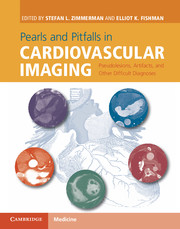 Pearls and Pitfalls in Cardiovascular Imaging
Pearls and Pitfalls in Cardiovascular Imaging from Section 9 - Mesenteric vascular
Published online by Cambridge University Press: 05 June 2015
Imaging description
In the classic anatomy, the common hepatic artery (CHA), left gastric artery (LGA) and splenic artery (SA) arise from the celiac axis (CA), and the superior mesenteric artery (SMA) arises from the aorta without an aberrant or accessory hepatic artery (61–76% of normal population) (Figure 84.1). There are multiple types of variant anatomy of these vessels. The most common variations are a replaced or accessory left hepatic artery originating from the LGA (9.7–12.5%), a replaced or accessory right hepatic artery originating from the SMA (7.5–10.6%), or a combination of replaced or accessory right and left hepatic arteries (2.3– 4.5%) (Figure 84.2). Less commonly, the origin of the CHA arises from the SMA (1.5–3%) (Figure 84.3) or directly from the aorta (0.2–2%) (Figures 84.4 and 84.5). In these cases the splenic artery and left gastric artery often arise directly from the aorta (gastrosplenic, or lienogastric trunk) (Figures 84.3 and 84.5). Common origin of the CA and SMA (celiacomesenteric trunk) is seen in 0.7–1.1% of population (Figure 84.6). Other uncommon variations include the splenic artery originating from SMA (splenomesenteric trunk) (0.24% [5]) (Figure 84.7), and the CHA originating from the left gastric artery (hepaticogastric trunk) (0.2– 0.3%) (Figure 84.7). Additional very rare patterns also have been described.
Typically, the common hepatic artery has a suprapancreatic, preportal course; however, there can be a variation in the pathway of CHA, such as a retrocaval course or passing through the pancreatic parenchyma, particularly when the CHA arises from the SMA (Figure 84.3).
Importance
For preoperative planning of the abdominal surgery, it is important to understand the celiac axis, hepatic arterial, and mesenteric arterial anatomy to avoid or minimize serious ischemic complications. To perform interventional radiologic procedures such as intra-arterial hepatic tumor management and embolotherapy for hemorrhage, preprocedural evaluation of variant celiac axis and hepatic arterial anatomy is important for treatment planning.
To save this book to your Kindle, first ensure [email protected] is added to your Approved Personal Document E-mail List under your Personal Document Settings on the Manage Your Content and Devices page of your Amazon account. Then enter the ‘name’ part of your Kindle email address below. Find out more about saving to your Kindle.
Note you can select to save to either the @free.kindle.com or @kindle.com variations. ‘@free.kindle.com’ emails are free but can only be saved to your device when it is connected to wi-fi. ‘@kindle.com’ emails can be delivered even when you are not connected to wi-fi, but note that service fees apply.
Find out more about the Kindle Personal Document Service.
To save content items to your account, please confirm that you agree to abide by our usage policies. If this is the first time you use this feature, you will be asked to authorise Cambridge Core to connect with your account. Find out more about saving content to Dropbox.
To save content items to your account, please confirm that you agree to abide by our usage policies. If this is the first time you use this feature, you will be asked to authorise Cambridge Core to connect with your account. Find out more about saving content to Google Drive.